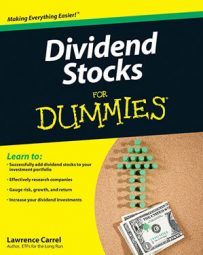People measure the health of the stock market with various indexes, which are like thermometers for the stock market. When business is good, the index tends to rise. When business is bad, it falls. Thousands of indexes measure industrial sectors and business performance in the United States and every other country in the world.
Two indexes — The Dow Jones Industrial Average (DJIA) and the Standard & Poor’s 500 Index —are known as the stock market’s benchmarks. They not only measure the health of the stock market but also provide a historical basis from which you can derive data, gain valuable perspective on what’s going on in the markets, and draw conclusions. When the media say the stock market is up or down, they mean the Dow and the S&P 500 are up or down. When they say the market is mixed, they mean these two indexes are going in opposite directions. The indexes are important to you because most of the stocks on them pay dividends.
Dow Jones Industrial Average
Invented in 1896 to track just 12 companies, the Dow Jones Industrial Average is the oldest stock market index. It goes by a few nicknames, such as the Dow Industrials and the DJIA, but most people know it simply as the Dow. Today, the Dow consists of just 30 companies in the major industries in the United States.
Critics complain that the sample of 30 companies is too small to serve as an accurate measure of the stock market’s performance and that its price weighting doesn’t take into account the sizes of the companies in the index. However, the Dow has been measuring the stock market for more than 113 years, which gives it a lot of credibility.
Price weighting values companies based on their share price, not total market value. As its name says, the Dow is an average. So a company with a share price of $50 makes up five times more of the index than a company with a share price of just $10, even if the lower priced stock produces twice the profits or has more shares trading in the market.
Standard & Poor’s 500
Better known as the S&P 500 or just the S&P, the Standard & Poor’s 500 Index holds 500 of the largest companies in the U.S., but not necessarily the top 500. Created in 1957, the S&P is considered a more representative index because it holds about one-tenth of all the publicly traded companies. More importantly, this tenth of the market’s companies collectively represents about 75 percent of the stock market’s total dollar value.
The index weights the companies based on their value in the market — a value measured by the company’s market capitalization:
Market Capitalization = Share Price x Number of Outstanding Common Shares
For example, in early 2009, ExxonMobil was the largest company in the index, with a market capitalization of $338 billion. It held an index weighting of 4.86 percent. AT&T, the second-largest company, wasn’t quite half the size of Exxon, with a market capitalization of just $148 billion, so its weighting of 2.14 percent was less than half of Exxon’s weighting. Giving larger companies more influence over the index makes the S&P 500 a more accurate measuring tool for the broad market.
Outstanding stock tells you the number of shares the company has sold to investors and can now trade on the market.
Other Indicators
In addition to the Dow Jones and S&P 500, the NASDAQ Composite Index has become a benchmark for the NASDAQ Stock Market. The majority of its components don’t pay dividends. Most are small, high-growth stocks, such as technology and biotechnology.
To take the temperature of the energy sector or the financial sector, you can find an index specifically for those industries. If you want an index of just dividend stocks, you can find that too.

